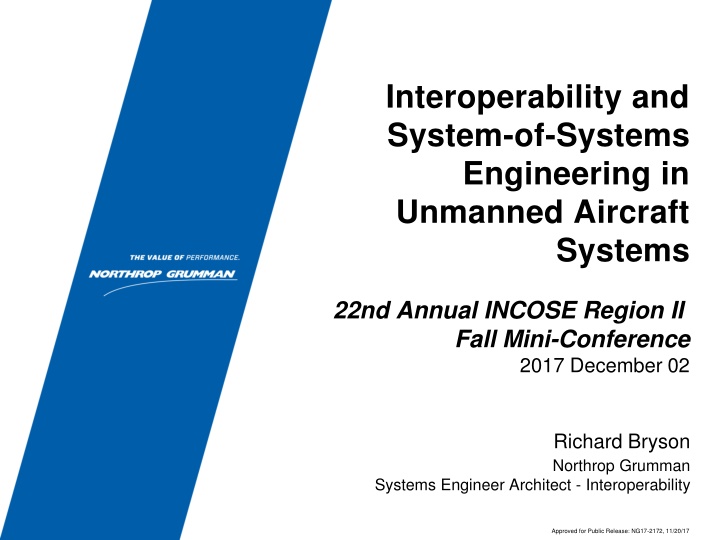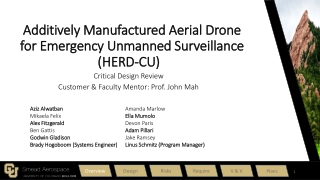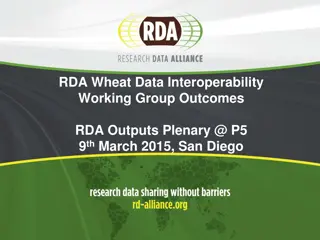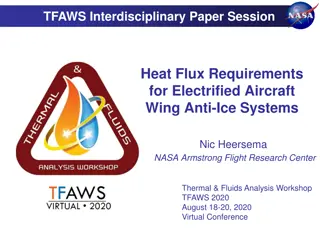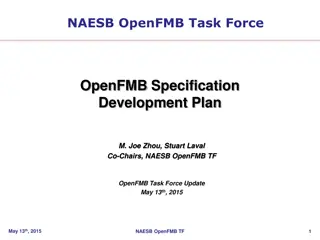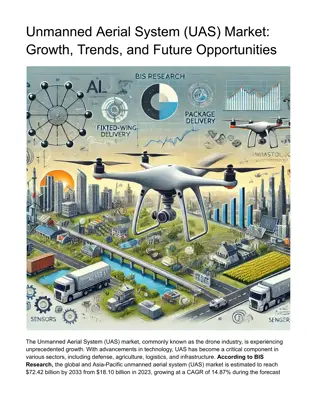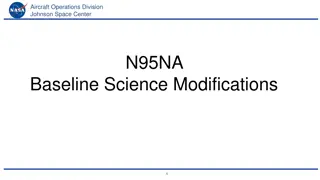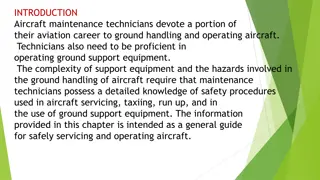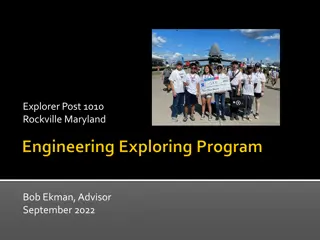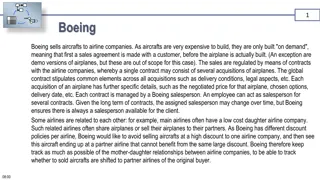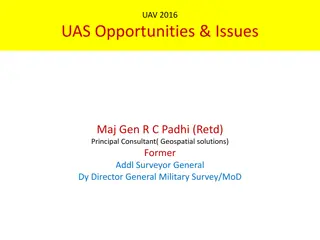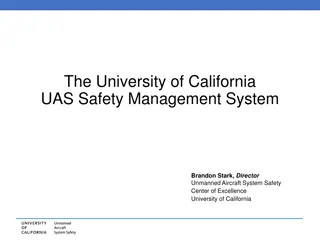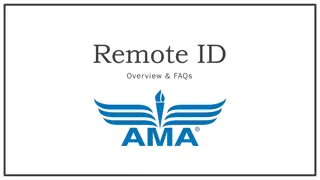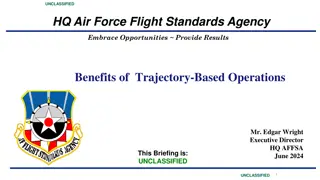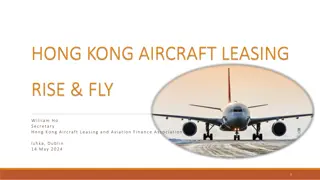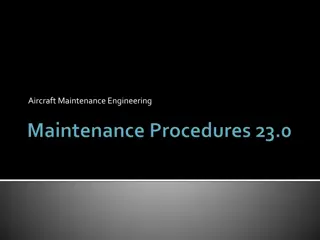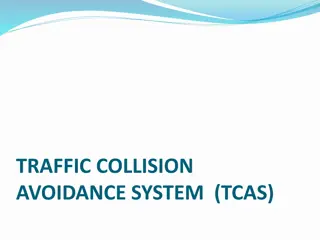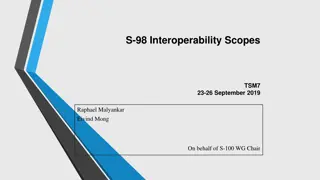Interoperability and System-of-Systems Engineering in Unmanned Aircraft Systems
This presentation on interoperability and system-of-systems engineering in unmanned aircraft systems delves into the definitions, integration approaches, standards, and examples of interoperability issues. The speaker, Richard Bryson, a systems engineer architect at Northrop Grumman, provides insights into the role of interoperability engineers and how they relate to system-of-systems engineering. The content also includes a bio of Bryson, outlining his educational background and work experience in software development methodologies, system engineering, and project management.
Download Presentation

Please find below an Image/Link to download the presentation.
The content on the website is provided AS IS for your information and personal use only. It may not be sold, licensed, or shared on other websites without obtaining consent from the author.If you encounter any issues during the download, it is possible that the publisher has removed the file from their server.
You are allowed to download the files provided on this website for personal or commercial use, subject to the condition that they are used lawfully. All files are the property of their respective owners.
The content on the website is provided AS IS for your information and personal use only. It may not be sold, licensed, or shared on other websites without obtaining consent from the author.
E N D
Presentation Transcript
Interoperability and System-of-Systems Engineering in Unmanned Aircraft Systems 22nd Annual INCOSE Region II Fall Mini-Conference 2017 December 02 Richard Bryson Northrop Grumman Systems Engineer Architect - Interoperability Approved for Public Release: NG17-2172, 11/20/17
Outline Bio Interoperability Definitions How does it relate to System-of-Systems engineering? What does an Interoperability Engineer do and when? Best integration approach: Top-down or Bottom-up? Interoperability Standards The EICD Some Good Examples of Bad Interop Jobs Summary 2 Approved for Public Release: NG17-2172, 11/20/17
Bio BS in Math, Univ of Redlands 1978 my passion, but what am I going to do with this degree? <<crickets>> MS in Computer Science, USC 1982 a more practical education Work timeline: 1978 1980 1982 1984 1986 1988 1990 1992 1994 1996 1998 2000 2002 2004 2006 2008 2010 2012 2014 2016 2018 Software Development Methodologies, Software Management SE Manager, SE Architect Interop for UAVs and BMC2 GS MILSTAR, Telecom, Range Systems, Port Security, UAVs Data Structures, Software Development Methodologies, gde systems inc SWE, PM, SE for NGA contracts SW Project Manager for Automatic Voice Response systems Simpact Associates, Inc. Ada Systems Development Corp (ASDC): Instructor Integrated CNI & EW SWE, SW PM, budding SE JTIDS/PLRS SWE 1978 1980 1982 1984 1986 1988 1990 1992 1994 1996 1998 2000 2002 2004 2006 2008 2010 2012 2014 2016 2018 Hmmm Did most of these companies disappear because Bryson worked for them? 3 Approved for Public Release: NG17-2172, 11/20/17
A Typical Unmanned Aircraft System (UAS) of Systems (SoS) Interface Diagram: Many Interfaces! UAV Ground Segment UAV Sensor EO/IR/RADAR NITF Frames NITF Frames Scene Tie-Up MOC Target Deck UAV Control Center JTAAC PED Front end with CIP Frames JTAAC Mosaicker NITF Mosaic MOC Target Deck JTAAC ATC MOC, IMS & Screener ATC Cues JTAAC Operator JPEG Mosaic Exploiter Exploited Target Cues Web Access Web Access Mosaic + Cue Web Page Chat Rooms Web Portal IPL Mosaic Web Page End-users (Mosaics +cues) End-users (Mosaics only) Everything should be made as simple as possible, but not simpler. A. Einstein 4 Approved for Public Release: NG17-2172, 11/20/17
Net-Centricity Net-centric (NC) (Wikipedia) Net-centric refers to participating as a part of a continuously-evolving, complex community of people, devices, information and services interconnected by a communications network to achieve optimal benefit of resources and better synchronization of events and their consequences. You say net-centric I say net-ready (NR) It s the same thing: NR is defined in terms of NC The NR Key Performance Parameter (KPP) (Wikipedia) The NR KPP identifies operational, net-centric requirements in terms of threshold and objective values for Measures of Effectivity (MOE) / Measures of Performance (MOP). The NR KPP covers all communication, computing, and EM spectrum requirements involving information elements among producer, sender, receiver, and consumer. i.e., What a program office requires in terms of effectively integrating network- based connectivity into a system Net-centricity helps produce more-interoperable systems 5 Approved for Public Release: NG17-2172, 11/20/17
What isnt Interoperability? Does NC guarantee Interoperability? No. One can have two net-centric systems or components that don t interoperate well at all Different networks, different protocols, different message sets, badly programmed behavior The system in the previous graphic was net-centric the connections in the yellow box were all networks But it is STILL striving to become fully interoperable 10 years after initial field testing To whom am I speaking? No thanks; just had an orange. New RAZR? Are all Interoperable systems NC? No. There are plenty of non-NC systems that do interoperate Including all those that pre-dated networks Release the hounds The SEs are coming! The SEs are coming! Net-centricity is neither necessary nor sufficient to ensure Interoperability but it helps 6 Approved for Public Release: NG17-2172, 11/20/17
What, then, is Interoperability? Interoperability is, in most basic terms The well-defined and correctly used set of all external interfaces in a system Connections e.g. networks Protocols Data Flows Expected/documented behavior: When I send this, what happens? What do I get back? Having most connections be NC is good, but neither necessary nor sufficient Ref: UCI website @ https://www.vdl.afrl.af.mil/programs/uci/about.php Using MIL or industry standards is good, but neither necessary nor sufficient An OV-1 Diagram (high-level System Connectivity diagram) for a notional multi-aircraft battle management system Some systems (of systems) are incredibly complex so full interoperability is both difficult and absolutely essential Repeat after me: Do not drop the bomb on the nursery school! The physical & message interface itself is only the starting point It s not sufficient to just be able to send data each way Must process it properly Interoperability is a simple concept, essential to achieve, difficult to well-define 7 Approved for Public Release: NG17-2172, 11/20/17
How Does Interoperability Relate to SoS? System System of Systems (SoS) means a collaborative set of related systems Each individual system has its own contract, spec, development cycle, etc. e.g., each system in the diagram is a separately contracted complex system with its own segments, subsystems, and components But when these systems need to collaborate, or interoperate, it s a system of systems Sometimes called an enterprise, but that term is overloaded, too System System System But even individual systems must have interoperable components It s a matter of scale and context System System System System One man s SoS is another woman s system is another person s subsystem 8 Approved for Public Release: NG17-2172, 11/20/17
When Do Interoperability Engineers Engage in a System s or SoS s Development? Throughout the process Before the beginning Studies, prototypes, proposals, At the beginning Interop rqmts in spec, arch design, build-to External ICDs (EICD) In the middle Develop test-to EICDs, interop test plans for I&T, FAT, SAT, DT, FT, OT At the end Lab test, DT, OT, as-built EICDs After the end DT, OT, O&M/Sustainment, ECPs And of course those administrivia tasks that permeate the development cycle Risks, schedules, briefings, etc. Note the presence of the EICD it s importance cannot be overstated. (More on EICD later) The later you engage as an Interop Engineer, the harder your job will be Rework abounds! Engage as soon as possible and start solving the interop problems before they become problems SoS/Interop Engineers play a vital role(s) throughout the developmental cycle 9 Approved for Public Release: NG17-2172, 11/20/17
Top-down or Bottom-up Development? Answer: Outside-in! FIRST define the external interfaces around the black box Or they could be defined already by the external connections We can hope they are standard interconnects THEN open up the black box (the system under development) and build the components inside to meet the required external interfaces Consider Your Home Entertainment System To achieve the best interoperability, always start design from the outside-in 10 Approved for Public Release: NG17-2172, 11/20/17
A normal-world example of outside-in integration Unless you have an all-in-one box like an iPod or Bose Wave, you need to integrate the components together Need standard interconnections to avoid, e.g.: soldering wires from the inside of one component to the inside of another mismatched impedance that will blow your speakers incompatible ports, cables, connectors But want options on the interconnections to select highest fidelity for budget $1/yard standard cable? or $100/foot stereophile cable? And good manuals And online training if necessary etc. If designing the integrated amp above, best to start from the outside, with the standardized connections, and then work up the design of the inside of the amp. If start inside (top-down or bottom-up) chance of meeting the standards is near nil. Not so different from what we need for the SoSs we deal with in our work lives 11 Approved for Public Release: NG17-2172, 11/20/17
Interoperability-Related Standards So you say you need a standard ? Here, have a dozen or so! Std Org <2005 2006 2007 2008 2009 2010 2011 2012 2013 2014 2015 2016 2017 4586 NATO North Atlantic Treaty Organization Standardization Agreement (STANAG) 4586 UCI USAF COS UCI UAS C2 Control Initiative UCI* IOP Army IOP Interoperability Profile UCS OSD UCS UAS Control Segment Architecture OMS USAF OMS Open Mission Systems FACE Navy Future Airborne Capability Environment NIOP Navy Navy Inter-Operability Profile CoT Mitre CoT Cursor on Target SOA industry Service-Oriented Architecture (not a standard, but a design approach underlying others in this table) OSA industry Open Architecture/Open Systems Architecture (ditto) ACTDF USAF ACRM ACTM Aircraft Tasking Data Format (ACTDF) ACTDF v3.3 T3D USAF Tasked Target Text Data T3D v8.0 XML ISO Extensible Markup Language DoD/IC/ ISO/IEC NITF National Imagery Transmission Format 4607 NATO STANAG Ground Moving Target Indicator Format (GMTIF) * UCI Renamed Universal C2 Interface in 2017 XML-based Provides a standard message catalog and schema for providing flight & sensor Command & Control and status among participating manned and unmanned platforms and ground stations Goal is to allow machine-to-machine processing, with operators on or in the loop as desired What s the chance any of these interop standards are mutually interoperable? 12 Approved for Public Release: NG17-2172, 11/20/17
Beyond Standards Standards provide the starting point for interoperability, but don t always accomplish standardization much less mutual interoperability RS232 (old timers!) A standard indeed, but so many options, even for this small standard, that RS-232-compatible became a joke XMLallows one to define one s own schema with text-based tags and data, so no inherent interoperability (but enables interoperability!) A NITF field definition might allow a sensor to swing 90 degrees from nadir, but your radar has hard stops at 80 and will be damaged if slewed beyond them UCI schema might have Altitude as an optional field, but your ground segment requires it to be populated MPEG: are you using a compatible I-frame rate? Valerie: Think it ll work? Miracle Max: It would take a miracle. Standards, while indispensable, do not guarantee interoperability 13 Approved for Public Release: NG17-2172, 11/20/17
The External Interface Control Doc (EICD) Use an external interface control document (EICD) or the like, coupled with an Memo of Understanding (MOU) between program offices directing that the EICD is ground truth Standard XYZ Message A Option 1: Duplicate the standard s message and tailor the fields to meet your interface needs Good, if tedious, when a large portion of the standard must be tailored This is what we did for one recent program Field 1 set to 10 Field 2 leave per std Field 3 leave per std Field 4 restrict to 5 to 15 secs Field 5 leave unpopulated Field 6 START , IN WORK , DONE Option 2: Provide delta tables that define only those fields where you are deviating or further restricting/defining what s in the standard Good when the vast amount of the standard will be used as-is This is what I plan to do on my current program Message A Deltas Field 1 set to 10 Field 6 FAILED , DONE The EICD: An interchange contract between systems 14 Approved for Public Release: NG17-2172, 11/20/17
Typical EICD Content An EICD should provide information to fully define an interface in a way to meet interoperability, including as examples: Textual descriptions of the interface including behavior Diagrams OV-1 OV-2 Network Diagrams Message Sequence Diagrams Message Catalog Direction of flow of the message from source to destination Protocols Physical connections & appliances etc. Tailoring of the standards Standard-optional fields that are mandatory for this interface Extensions (if allowed) Range/value restrictions beyond what the standard allows Expected behavior, responses Reference documents the standards used at least Cyber Security considerations such as Enclaves DMZs Compliance checklist A good EICD tailors standards to promote interoperability 15 Approved for Public Release: NG17-2172, 11/20/17
EICD Table Fictional Example Tables can express a lot of information compactly and accurately Especially when accompanied by relevant network and data flow diagrams (OV-2) and behavioral descriptions Table 5-12: Bryson Air Vehicle (BAV) Message Flow (Notional) Message From To Connection Type Protocol Class Crypto Notes AV Position Air Vehicle AV Ground Station UHF SATCOM BAV XML Custom** Secret KG135 **See BAV SATCOM EICD Position Report AV Ground Station BMC2 Node SIPRNet UCI v72 UDP/IP Secret KG175 Position Report Reply BMC2 Node AV Ground Station BMC2 LAN UCI v72 TCP/IP Unclass n/a Radar Task AV Ground Station Air Vehicle SIPRNet BAV XML TCP/IP Secret KG175 SAR Image Air Vehicle AV Ground Station BMC2 LAN NITF 2.1 sftp Unclass KG255 Mosaicked Image AV Ground Station BMC2 Node SIPRNet NITF 2.1 NFS Secret n/a Goal: Make life as easy as possible for your readers: SWEs, SEs, PMs, Customers 16 Approved for Public Release: NG17-2172, 11/20/17
Good Real-life Examples of Bad Interop/SoS Engineering Gapfiller Situational Awareness Messages It s not my problem 17 Approved for Public Release: NG17-2172, 11/20/17
Gapfiller Situational Awareness (1 of 2) The Originally Defined Situational Awareness (SA) Message Catalog AV Position Nav Plan Collection Plan Collection Status Sent once/sec Sent upon change Sent upon change (in whole or part) Sent upon change per Task Tail # Tail # Tail # Tail # Latitude Nav Plan ID Task #1 Task Status = Longitude Waypoint #1 Task Type Pending Altitude Latitude Target Location In Process Fly-to Waypoint Longitude Altitude Time to Collect Collected Comms Status o o o Task #m Downlinked o o o Waypoint #n Latitude Sent upon change Deleted Tail # Failed WB SATCOM Status WB LOS Status Task Type Cmd Link Status Target Location Longitude Cmd BU Link Status Time to Collect Altitude Well-defined, topic-oriented, uses periodic message only for periodic data. As simple as possible but no simpler 18 Approved for Public Release: NG17-2172, 11/20/17
Gapfiller Situational Awareness (2 of 2) The Gapfiller SA Message Catalog In Jan 2007, a 1-2 year gapfiller SA message set was defined due to budget constraints In 2017 Gapfiller lives! And costs much more It s everything wrong you learned about data design Forced periodicity of non- periodic data Bundling of unrelated data Big kludge for ad hoc collects No indicator of Short vs Full messages Missing a critical key for an external user Full Message Short Message Sent once/min Sent once/sec Unless it s time for a Full Message instead Tail # Tail # AV Position Section AV Position Section Comms Status Section Comms Status Section Full Nav Plan every single time! 1000s of waypoints, every single time! Current Fly-to Waypoint Collection Status For those Tasks completed since the last Full Message was sent Oh, but wait, what about Tasks added since the last Full Message? So, better add Collection Plan info for those added since then! Collection Plan for time NOW forward Catches changes, but lots of repetition every single time Collection Status for any/all tasks completed since last Full or Short message Collection Plan Info for Ad Hoc Tasks Added Since Last Full Message Lesson learned: As stubborn as I am, sometimes I am not stubborn enough 19 Approved for Public Release: NG17-2172, 11/20/17
Its Not My Problem Bkgnd: The Sensor Management SW (SMS) was not interfacing correctly with the Flight Management SW (FMS) Richard to SMS SWE: We need to get you and the FMS SWEs together to work out the problems. SMS SWE: That s not my job. I meet my SRS. Richard: But the whole system needs to work or we all lose our jobs. Your SRS might need to be updated. SMS SWE: But that s not my problem. My SW meets my SRS. Richard: OK, this conversation (and all others with you in the future) is over. SMS SWE left the company soon thereafter Everyone should be a Systems Engineer but not everyone can. Goes double for SoS/Interoperability Engineering 20 Approved for Public Release: NG17-2172, 11/20/17
A (Notional & Partial) Hierarchy of a Systems of Systems of Systems of Systems We ll be back! Skynet (The sky s not really the limit.) Increasing Power & Complexity Integrated DoD Weapons System Joint Services ISR Enterprise Joint Services Strike Enterprise Air Force ISR Enterprise Battle Management Enterprise Unmanned Air System (UAS) Exploitation System BMC2 Node AV Ground Station Air Vehicle One man s system of systems might become Skynet! 21 Approved for Public Release: NG17-2172, 11/20/17
Summary Interoperability and Net-Centricity are related, but not synonymous Interoperability and SoS Engineering are virtually synonymous EICDs (w/MOUs) are essential Employ Outside-in Development Work from the external interfaces inward As they say in Chicago: Vote Early & Often i.e., Get involved as early as possible to fend off as many future problems as possible Be bold! Be stubborn! Don t let Customers, PMs, SE Mgrs, other naysayers dissuade you from sticking your nose in wherever necessary Learn to speak and preach Interoperability maH jatlh tlhIngan! Listen to Einstein! Do keep things as simple as possible but not simpler System of Systems Engineering: Think of it as evolution in action but YOU must intervene and provide the intelligence in the design 22 Approved for Public Release: NG17-2172, 11/20/17
Backup Approved for Public Release: NG17-2172, 11/20/17
Notes to Self (not part of briefing) Briefing Release Process: http://eprocs.northgrum.com/firstVisit.asp Working Title: Interoperability and System-of-Systems Engineering in Unmanned Aircraft Systems Abstract: Evaluates several questions of interoperability and systems-of-systems engineering, including what exactly is interoperability? How does it relate to system-of-systems engineering? What is best approach to development of interoperable systems: top-down, bottom-up, or something else? Are there any interoperability standards? Then provides examples of how interoperability was infused into complex unmanned aircraft and ground control systems. 26 Approved for Public Release: NG17-2172, 11/20/17
